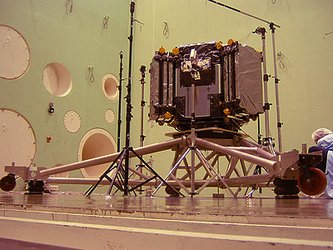ESA's water mission instrument passes test programme
After successfully undergoing a rigorous three-month testing programme, the innovative SMOS (Soil Moisture and Ocean Salinity) payload is about to make its journey from ESA's Test Centre in the Netherlands to France, where it will join the platform to form the satellite in preparation for launch next year.
After more than 10 years of research and development, the SMOS mission is adopting a completely new approach in the field of remote sensing by employing a novel instrument called MIRAS (Microwave Imaging Radiometer using Aperture Synthesis). By capturing images of microwave radiation emitted from the surface of the Earth at a specific wavelength, this novel instrument is capable of observing both the moisture in soil and salt in the oceans. MIRAS will be the first-ever 2-D interferometric radiometer in space and will provide much-needed data to learn more about the continual circulation of water between the oceans, the atmosphere and the land – the Earth's water cycle, one of the most important processes occurring on the planet and a crucial component of the weather and climate.

Making sure the instrument will withstand the rigors of launch and the harsh environment in orbit is an extremely important part of the mission development. Therefore, with launch scheduled for next year, MIRAS had to undergo an extensive testing programme in ESA's Test Centre.
In balance
After delivery from the instrument prime contractor EADS-CASA in Spain, the testing programme started with determining the instrument's 'mass properties'. This included precisely measuring its overall weight, locating the centre of gravity and the inertia around its three principle axes. These values are crucial for both tuning the launcher trajectory and as input for the satellite's Attitude and Orbit Control System.
Noise
The instrument module consists of a central structure and three deployable arms. These arms were folded up for the next testing procedure when the instrument was placed in the Large European Acoustic Facility. Here the tremendous noise and vibrations levels that are expected to be experienced under the launcher's fairing were simulated.

Temperature extremes
Having survived the acoustic tests, the instrument was transferred to the Large Space Simulator. This is a massive vacuum chamber where the extreme temperature differences of space are simulated. A solar beam, six metres in diameter, was repeatedly shone onto the instrument and then the instrument was subjected to extreme cold similar to that of deep space. Not only does the payload need to function properly under these extremes, the thermal environment and temperature distribution across the body of the three arms is an important factor for MIRAS's overall measurement performance. For the test to be meaningful, the instrument's three arms had to be fully deployed – suspended like a string puppet it just fitted into the 10-metre diameter chamber. These thermal tests continued around the clock for almost 3 weeks.

Testing images
Finally, the instrument was set up in what is called the Maxwell Facility for two types of tests – the electromagnetic compatibility test, which makes sure that nothing is disturbed when, for example, the data downlink is activated, and the image validation test, which is where an artificial source mounted on the ceiling is 'imaged' by the instrument under different conditions. In addition, tests were performed on the algorithms and software for the Level 1 processor, which converts digital counts into pictures for scientists to derive information on soil moisture and ocean salinity.
The engineers and scientists involved in this intensive testing programme are extremely pleased with the results and the MIRAS instrument is now in the process of being packed up for delivery to Thales Alenia Space (formerly Alcatel Alenia Space) in Cannes, where it will be joined with the PROTEUS platform to form the entire SMOS satellite.
Now confident that the instrument will survive the rigors of launch and its lifetime in space, ESA looks forward to the launch of the SMOS satellite from the Plesetsk Cosmodrome in northern Russia next year.















 Germany
Germany
 Austria
Austria
 Belgium
Belgium
 Denmark
Denmark
 Spain
Spain
 Estonia
Estonia
 Finland
Finland
 France
France
 Greece
Greece
 Hungary
Hungary
 Ireland
Ireland
 Italy
Italy
 Luxembourg
Luxembourg
 Norway
Norway
 The Netherlands
The Netherlands
 Poland
Poland
 Portugal
Portugal
 Czechia
Czechia
 Romania
Romania
 United Kingdom
United Kingdom
 Slovenia
Slovenia
 Sweden
Sweden
 Switzerland
Switzerland
































